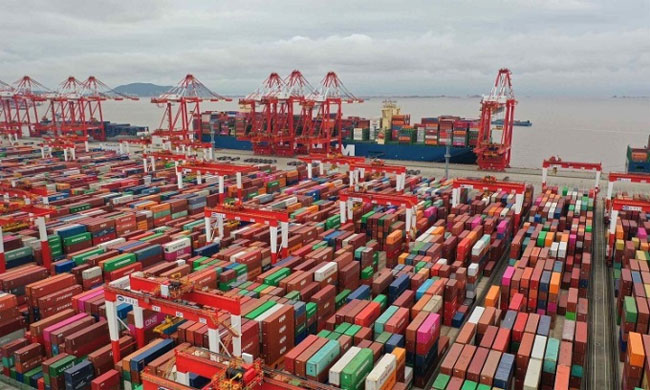The largest container terminal in the world located in Shanghai focuses on most of the smart and large-scale automation technologies in the maritime sector.
The Yangshan Deep-Water Port, situated in Hangzhou Bay, is home to the largest automated container terminal in the world, which began operations in December 2017. Covering an area of 2.23 million square meters and with a coastline of 2,350 meters, the port can handle 4 million TEUs (TEU is a unit that measures the capacity of a standard 6-meter container). Despite being busy, the port employs virtually no workers thanks to a fully automated management and control system developed by the Shanghai International Port Group (SIPG), which facilitates the entire process using artificial intelligence, including container loading and unloading, horizontal transportation, and yard arrangement.

Yangshan Deep-Water Port on May 19, 2021. (Photo: CFP).
Connected to the main data and information platform of the Port of Shanghai, the production organization system efficiently manages local operations through scheduling and process control collaboration. Instead of working on-site, port operators now work in control rooms, performing all tasks in front of computer screens. The automated container terminal has 7 berths, capable of accommodating container ships weighing up to 200,000 tons. Huang Xiusong, the director of the technology center at SIPG, stated that the terminal can complete the unloading of 5,000 TEUs within 16 to 24 hours.
Streamlining the transportation process requires careful consideration of every detail, such as docking areas and machinery needed for unloading goods. The intelligent system developed by SIPG has now replaced manual labor in repetitive tasks. In the past, experienced workers would typically take 3 to 4 hours to arrange containers for a single ship. Currently, the arrangement time has been reduced to 15 minutes, as the automated system can receive all information from the moment the ship enters the docking position and automatically proposes the most efficient solutions to ensure smooth port operations.
Automated remote control technology allows operators to transition from a 50-meter crane cabin to a control room. They only need to press a button or pull a lever to control operations based on real-time information displayed on screens. Without remote control technology, the container terminal would require at least 700 workers instead of the current 100, according to Fang Huaijin, vice president of SIPG.
The automated container terminal at Yangshan is also the first in Asia to implement Automated Guided Vehicles (AGVs). Relying on ground-mounted markers, AGVs transport containers to locations instead of using trucks. The vehicles take only 6 minutes to change batteries and two hours to fully charge. Moreover, the entire charging process is emission-free, saving over 40% in energy consumption. The high level of automation contributes to operational efficiency and superior annual output. In 2018, the automated container terminal handled 2.01 million TEUs. In 2019, the number increased to 3.27 million TEUs, and by 2020, it exceeded 4.2 million TEUs.
The technical team aims to establish an intelligent control system in the future, integrating cloud computing, big data, artificial intelligence, and various other technologies to enhance accuracy and safety, and to operate more efficiently and environmentally friendly. This system will help raise the annual output of the automated container terminal to over 6 million TEUs.


















































